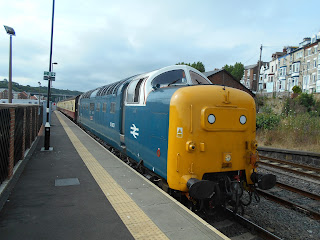As the British fashion invasion of the USA subsided, so did
the attraction of the Flying Scotsman. Ensuing financial troubles led to its
sitting derelict in a San Francisco switchyard for several years. In 1973, the steam
engine was brought back to England, and put back into special service, a mere
hint of its former glory. After an Australian tour in the late 1980s, it passed
through a succession of owners, no longer in the public eye. In 2004, the
British Railway Museum purchased the Flying Scotsman, and after a £4.2 million restoration project
(approximately $6.5 million), it is once again on tour.
Large crowds of railway enthusiasts now greet the Flying
Scotsman wherever it travels. Lady Ann learned that it would travel close to our
location during my visit; I insisted that we become part of that large crowd, railway
enthusiasts that we are.
 |
| Flying Scotsman |
So with that background, we visited the Flying Scotsman, and
guess what? It’s just another steam engine. We had expected a massive
locomotive of a size commensurate to its reputation. In truth, it’s no bigger
than any other engine. Just like every other steam engine, it eats coal a shovel
load at a time, and its wheels rotate and greet the track and it squeals and it
hisses. Worse yet, there wasn’t even a mini-skirted, knee-high booted entourage
of young women selling hats or T-shirts so we could pretend that we had been
impressed by what we saw and gloat among other railway enthusiasts. “Oh, yeah.
I saw the big one. I breathed its steam.”























































